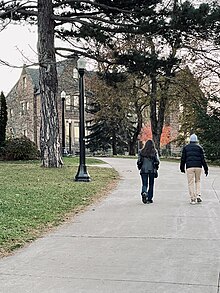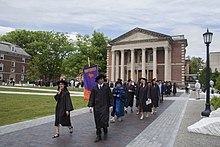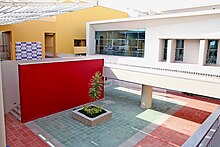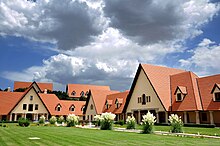Liberal arts college

A liberal arts college or liberal arts institution of higher education is a college with an emphasis on undergraduate study in liberal arts and general sciences. Such colleges aim to impart a broad general knowledge and develop general intellectual capacities, in contrast to a professional or vocational curriculum.[1] Students in a liberal arts college generally major in a particular discipline while receiving exposure to a wide range of academic subjects, including general sciences as well as the traditional humanities subjects taught as liberal arts. Although it draws on European antecedents,[2] the liberal arts college is strongly associated with American higher education, and most liberal arts colleges around the world draw explicitly on the American model.
There is no formal definition of a liberal arts college, but one American authority defines them as schools that "emphasize undergraduate education and award at least half of their degrees in the liberal arts fields of study."[3] Other researchers have adopted similar definitions.[4]
Although many liberal arts colleges are exclusively undergraduate, some also offer
Distinguishing characteristics
Liberal arts colleges are distinguished from other types of higher education chiefly by their generalist curricula and small size. These attributes have various secondary effects in terms of administration as well as student experience.[5] For example, class size is usually much lower at liberal arts colleges than at universities, and faculty at liberal arts colleges typically focus on teaching more than research.[6]
From a student perspective, a liberal arts college typically differs from other forms of higher education in the following areas: higher overall student satisfaction, a general feeling that professors take a personal interest in the student's education, and perception of encouragement to participate in discussion.[7] Many students select liberal arts colleges with precisely this sense of personal connection in mind.[7]
From an administrative standpoint, the small size of liberal arts colleges contributes to their cohesion and ability to survive through difficult times.
In addition, most liberal arts colleges are primarily residential,[citation needed] which means students live and learn away from home, often for the first time.
The distinctiveness of these attributes is somewhat eroded by the tendency of universities to adopt aspects of the liberal arts college, and vice versa.[10] For example, several American universities, including the University of California campuses in Santa Cruz and San Diego, developed a cluster colleges model in which small liberal-arts-college-like units within a larger university form a "honeycomb of residential colleges".[11] In addition, some universities have maintained a sub-unit that preserves many aspects of the liberal arts college, such as Columbia College within Columbia University.[10]
Liberal arts colleges themselves sometimes cluster to offer greater curricular breadth or share other resources (for instance Colgate University and Hamilton College in New York allow cross enrollment).[12]
Liberal arts and liberal arts college
In academia, liberal arts generally refer to subjects or skills that aim to provide general knowledge and comprise the arts, humanities, general sciences, and social sciences (rather than professional or technical skills).[13] Most liberal arts colleges, however, also offer courses in subjects that are not traditionally considered part of the liberal arts, such as computer science.[14]
Globally

Liberal arts colleges are found in all parts of the world. Notwithstanding the European origins of the concept of liberal arts education,[2] today the term is largely associated with the United States, and most self-identified liberal arts colleges worldwide are built on the American model.[16] The Global Liberal Arts Alliance, which incorporates institutions on five continents, refers to itself as "an international, multilateral partnership of American style liberal arts institutions."[17]
In 2009, liberal arts colleges from around the world formed the Global Liberal Arts Alliance, an international consortium and "matching service" to help liberal arts colleges in different countries deal with their shared problems.[18]
Keep in mind, U.S. News & World Report no longer provides rankings for liberal arts colleges at "global" universities. These colleges are members of the top 2,000 universities U.S. News & World Report ranks around the world.[19]
In North America

The liberal arts college model took root in the United States in the 19th century, as institutions spread that followed the model of early schools like Harvard, Yale, and Dartmouth, although none of these early American schools are regarded as liberal arts colleges today.[21] These colleges served as a means of spreading a basically European cultural model across the new country.[21] The model proliferated in the 19th century; some 212 small liberal arts colleges were established between 1850 and 1899.[22] As of 1987, there were about 540 liberal arts colleges in the United States.[4]
The oldest liberal arts college in America is considered to be
Most liberal arts colleges are private institutions, but a handful of public liberal arts schools exist (such as the University of Mary Washington in Fredericksburg, Virginia).
According to U.S. News & World Report, the top ten ranked Liberal Arts Colleges in America for 2022 are: Williams College, Amherst College, Swarthmore College, Pomona College, Wellesley College, Bowdoin College, United States Naval Academy, Claremont McKenna College, Carleton College, and Middlebury College, based on institutional stats and proprietary questionnaires .[20]
Liberal arts colleges in Canada include Acadia University, Bishop's University, Glendon College of York University, Mount Allison University, St. Francis Xavier University, Trent University, University of Lethbridge, and the University of King's College.
In South America
The leading organization is the National Institute of Educators of Liberal Arts and Artistic Education "Instituto Nacional Superior del Profesorado en Artes" located in
In Europe

With the exception of pioneering institutions such as
In the Netherlands, universities have opened constituent liberal arts colleges under the terminology "university college" since the late 1990s. This trend was spearheaded by Dutch sociologist Hans Adriaansens, who was "frustrated with the large-scale climate of university education in the Netherlands".[26] Dutch university colleges of this kind include Leiden University College The Hague, University College Utrecht, University College Maastricht, Amsterdam University College, University College Roosevelt, Erasmus University College, University College Groningen and University College Tilburg.
Other liberal arts colleges in continental Europe include
Although liberal arts colleges as such remain rare, liberal arts degree programs are beginning to establish themselves in Europe. For example, University College Dublin offers the degree, as does
In September 2016 Chavagnes Studium, a Liberal Arts centre in France, began offering a 2-year intensive BA in the Liberal Arts with a Catholic perspective.[35]
In Asia


International Christian University in Tokyo, which opened in 1953, defines itself as "Japan's first liberal arts college."[37] Other Japanese liberal arts programs include the other four members of the Global Five which includes School of International Liberal Studies at Waseda University, Akita International University, Ritsumeikan Asia Pacific University and Sophia University's Faculty of Liberal Arts.[38]
Yale-NUS College was started in 2011 as Singapore's first liberal arts college as a collaboration between Yale University in the United States and the National University of Singapore.[39] It attracted controversy over concerns that Yale was compromising on its liberal values by opening a college in a country where there are strong curbs on freedom of speech and assembly, with Yale faculty members expressing their "concern regarding the history of lack of respect for civil and political rights in the state of Singapore".[40] In response, many existing faculty and students have noted that there has been little repression of freedom of expression at the college and that it provides a great opportunity to promote the liberal arts in Asia.[41] In August 2021, NUS announced the closure of Yale-NUS College, with the Class of 2025 being the last cohort to receive an NUS degree. It will be replaced by NUS College, a merger between Yale-NUS College and the NUS University Scholars Programme.
Sogang University was founded as South Korea's first liberal arts college. In 1960, Jesuits founded Sogang College. Although, it became Sogang University in 1970, it is still following model of American liberal arts college in many aspects.[44] Seoul National University in South Korea established the College of Liberal Studies in 2007, initially as an educational project. However, after being established as a proper college in the SNU, it has become the only college that allows students to create their own major.[45]
Liberal arts colleges in India include undergraduate UG or bachelor's degree/diploma and postgraduate PG or master's degree/diploma as well as doctoral PhD and postdoctoral studies and research, in this academic discipline. The highly ranked
Also, Ahmedabad University, a private,[49] non-profit university offers its students a liberal education which is focused on research and interdisciplinary learning[50].

Baghdad College has offered a liberal arts curriculum since the early 20th century, but despite its name it has never offered more than a high school education.[citation needed] Effat University in Saudi Arabia, a women's institution, is a member of the Global Liberal Arts Alliance.[citation needed] Israel's first liberal arts college, Shalem College, was established in 2013.[51]
In Africa

Three institutions in Africa are members of the Global Liberal Arts Alliance:
In Australia
Campion College is a Roman Catholic dedicated liberal arts college located in the western suburbs of Sydney. Founded in 2006, it is the first tertiary educational liberal arts college of its kind in Australia. Campion offers a Bachelor of Arts in the Liberal Arts as its sole undergraduate degree. The key disciplines studied are history, literature, philosophy and theology.
The Millis Institute is the School of Liberal Arts at Christian Heritage College located in Brisbane. It offers a Bachelor of Arts in Liberal Arts in which students can choose to major in Philosophy, Theology, History or Literature.
A new School of Liberal Arts has been formed in the University of Wollongong; the new Arts course entitled 'Western Civilisation' was first offered in 2020. The interdisciplinary curriculum focuses on the classic intellectual and artistic literature of the Western tradition. Courses in the liberal arts have also been developed at the University of Sydney and University of Notre Dame.
Lists of schools
See also
- Liberal arts education
- Bachelor of Liberal Arts
- College of Arts and Sciences
- Liberal arts colleges in the United States
References
- ^ "Liberal Arts: Encyclopædia Britannica Concise". Encyclopædia Britannica. Archived from the original on 2008-02-15.
- ^ a b Harriman 1935.
- ^ "National Liberal Arts Colleges Rankings". U.S. News & World Report. Archived from the original on 2016-08-21. Retrieved 2015-01-08.
- ^ a b Clemmer 1997, p. 73.
- ^ Bonvillian & Murphy 1996, pp. 29–30.
- ^ Clemmer 1997, p. 78.
- ^ a b Bonvillian & Murphy 1996, p. 30.
- ^ Bonvillian & Murphy 1996, p. 29.
- ^ Clemmer 1997, p. 77.
- ^ a b Thelin 2004, p. 295.
- ^ Thelin 2004, pp. 295–296.
- ^ "Cross-Registration Guidelines" (PDF). Retrieved December 28, 2020.
- ^ "the definition of liberal arts". Dictionary.com. Archived from the original on 2016-10-17. Retrieved 2016-10-21.
- ISBN 0765807211.
- ^ "Mount Allison University: Tuition and Profile". Macleans.ca. Retrieved 2022-03-15.
- ^ Redden, Elizabeth (2009-02-16). "The Liberal Arts, Abroad". Inside Higher Ed. Archived from the original on 2015-01-10. Retrieved 2015-01-08.
- ^ "Global Liberal Arts Alliance". Archived from the original on 2015-01-09. Retrieved 2015-01-08.
- ^ Redden, Elizabeth (2009-04-06). "A Global Liberal Arts Alliance". Inside Higher Ed. Archived from the original on 2015-01-10. Retrieved 2015-01-08.
- ^ "How U.S. News Calculated the 2022–2023 Best Global Universities Subject Rankings". usnews.com. us news. Retrieved 24 March 2023.
- ^ a b "2021 Best National Liberal Arts Colleges". Retrieved July 22, 2022.
- ^ a b Bonvillian & Murphy 1996, p. 21.
- ^ Bonvillian & Murphy 1996, p. 23.
- ^ "Marianela Núñez: Premio María Ruanova – En su país reconocen su trayectoria". 7 June 2011.
- ^ "Historia". Retrieved 2 March 2014.
- ^ "About Franklin". Franklin University Switzerland Official Web Site. Franklin University Switzerland. Archived from the original on 2014-04-08. Retrieved 2014-07-03.
- ISBN 9781409423539.
- ^ "Berlin's sturdiest ivory tower". Expatica.com. Archived from the original on 17 December 2013. Retrieved 26 August 2013.
- ^ "Germany: New approach to liberal studies". Universityworldnews.com. 15 March 2009. Retrieved 26 August 2013.
- ^ "BA (Hons) Modern Liberal Arts". University of Winchester. Archived from the original on 25 May 2017. Retrieved 26 August 2013.
- ^ "Arts and Sciences (BASc) programmes". University College London. Archived from the original on 29 September 2013. Retrieved 26 August 2013.
- ^ "KCL – About Liberal Arts". Archived from the original on 7 January 2014. Retrieved 15 January 2014.
- ^ "Liberal Arts and Sciences Program (LAS)". University College Freiburg. Archived from the original on 20 August 2013. Retrieved 26 August 2013.
- ^ "Liberal Arts, Gothenburg University". Flov.gu.se. 22 May 2013. Archived from the original on 2 November 2013. Retrieved 26 August 2013.
- ^ "Liberal Arts Programme at Uppsala University". uu.se. Archived from the original on 30 June 2017. Retrieved 29 April 2018.
- ^ "The Chavagnes Studium | Catholic Liberal Arts Centre". Archived from the original on 2015-10-03. Retrieved 2015-10-01.
- ISBN 9781438429120.
- ^ Hibiya, Junko. "A Message from the President: Looking Into 'Issues of Living'". International Christian University. Archived from the original on 2015-01-08. Retrieved 2015-01-08.
- ^ "'Global' grads in demand at Japanese companies". Archived from the original on 2014-07-29. Retrieved 2014-07-29.
- ^ "Yale-NUS College to start accepting applications next year" (PDF). April 1, 2011. Archived (PDF) from the original on 2016-03-04. Retrieved 2015-03-10.
- ^ "Yale opens controversial college in Singapore". 27 August 2013. Archived from the original on 2015-04-03. Retrieved 2015-03-10.
- ^ Simon, Stephanie (29 December 2012). "Yale under fire for new campus in restrictive Singapore". Reuters. Archived from the original on 27 August 2016. Retrieved 23 November 2016.
- ^ "How to get a virtual UP education – Philstar.com". philstar.com. Archived from the original on 3 July 2017. Retrieved 29 April 2018.
- ^ "Kalayaan College | the Academe | PinoyExchange". Archived from the original on 2015-09-24. Retrieved 2015-08-04.
- ^ "조용히 변혁을 이끄는 선 굵은 유기풍 서강대 총장.. '올 코트 프레싱'". veritas-a.com (in Korean). 19 August 2015. Retrieved 2021-08-06.
- ^ "History". cls.snu.ac.kr (in Korean). Retrieved 2021-06-28.
- ^ "Experts focus on higher education, institution building in India". afternoondc.in. Archived from the original on 23 November 2016. Retrieved 23 November 2016.
- ^ "Member in the Global Liberal Arts Alliance". liberalartsalliance.org. Archived from the original on 25 May 2017. Retrieved 23 November 2016.
- ^ "FLAME University Announces Collaboration with Nuffield College in the University of Oxford, England". Business Wire India. The Telegraph. Archived from the original on 18 October 2016. Retrieved 23 November 2016.
- ^ "Financial Express". Archived from the original on 2017-12-30.
- ^ "Ahmedabad University Website". Archived from the original on 2017-12-28.
- ^ Melanie Lidman (13 January 2013). "Israel accredits first liberal arts college". Jerusalem Post. Retrieved 11 February 2022.
- ^ Redden, Elizabeth (2007-10-19). "A Liberal Arts College Marks Five Years in Ghana". Inside Higher Ed. Archived from the original on 2015-01-10. Retrieved 2015-01-08.
Works cited
- Bonvillian, Gary; Murphy, Robert (1996). The Liberal Arts College Adapting to Change: The Survival of Small Schools (2014 ebook ed.). Routledge. ISBN 9781135589332.
- Clemmer, Joel (1997). "The Liberal Arts College Library Director and the Collegiate Myth". In Dandraia, Frank (ed.). The Academic Library Director: Reflections on a Position in Transition (2013 ebook ed.). Routledge. ISBN 9781134755042.
- Harriman, Philip (1935). "Antecedents of the Liberal Arts College". The Journal of Higher Education. 6 (2): 63–71. JSTOR 1975506.
- Thelin, John R. (2004). A History of American Higher Education. Johns Hopkins University Press. ISBN 0801878551.
Further reading
- Morris, Edward. The Lindenwood Model: An Antidote for What Ails Undergraduate Education. University Press (2007)
- Pfnister, Allen O. "The Role of the Liberal Arts College." The Journal of Higher Education. Vol. 55, No. 2 (March/April 1984): 145–170.
- Reeves, Floyd W. "The Liberal-Arts College." The Journal of Higher Education. Vol. 1, No. 7 (1930): 373–380.
- Seidel, George. "Saving the Small College." The Journal of Higher Education. Vol. 39, No. 6 (1968): 339–342.
External links
- Global Liberal Arts Alliance
- Council of Public Liberal Arts Colleges
- Consortium of Liberal Arts Colleges
- How many (U.S.) colleges and universities have closed since 2016? A list maintained by Education Drive and updated in real time.
